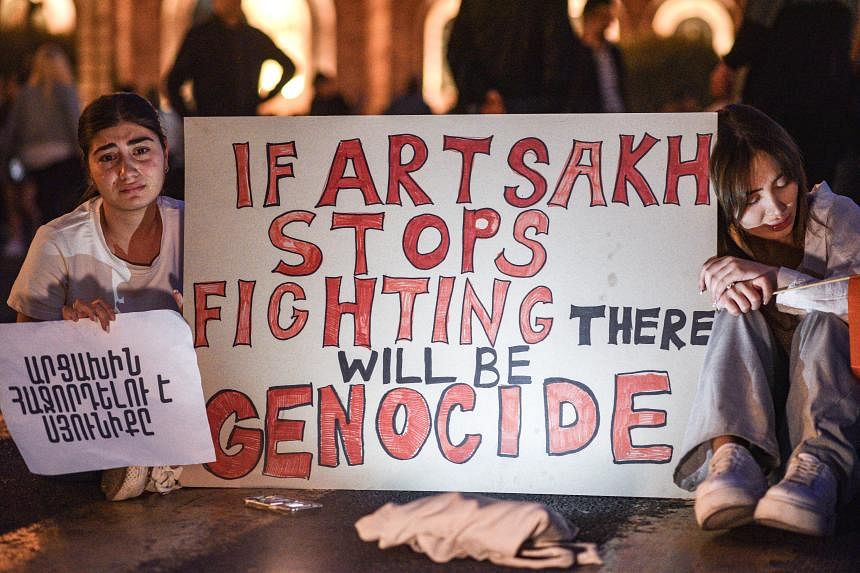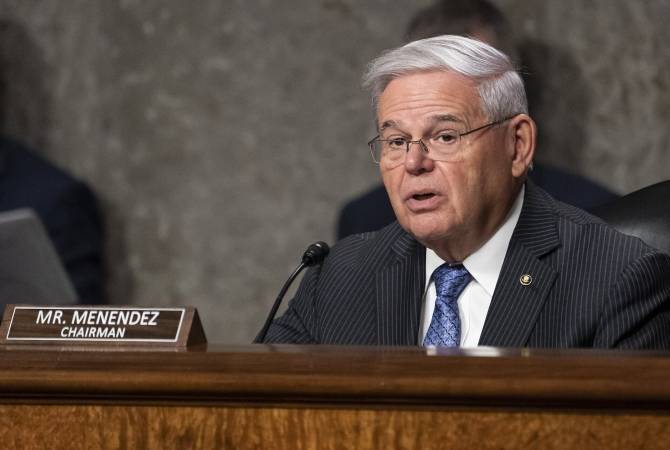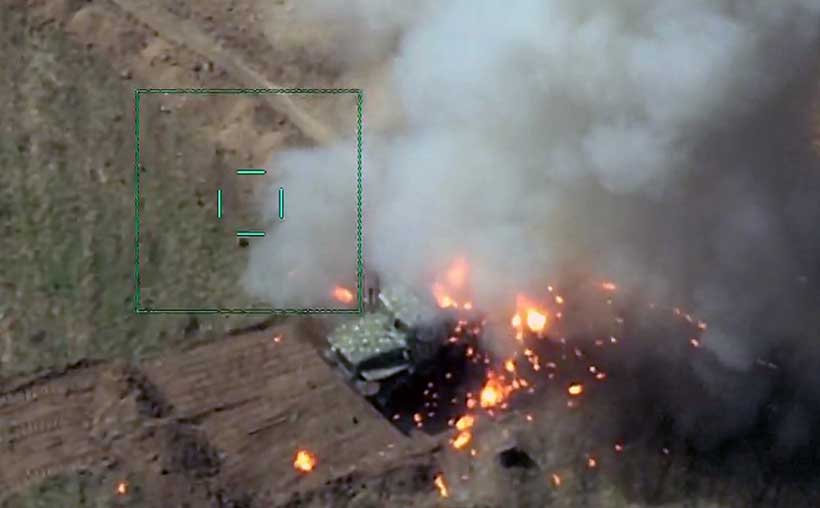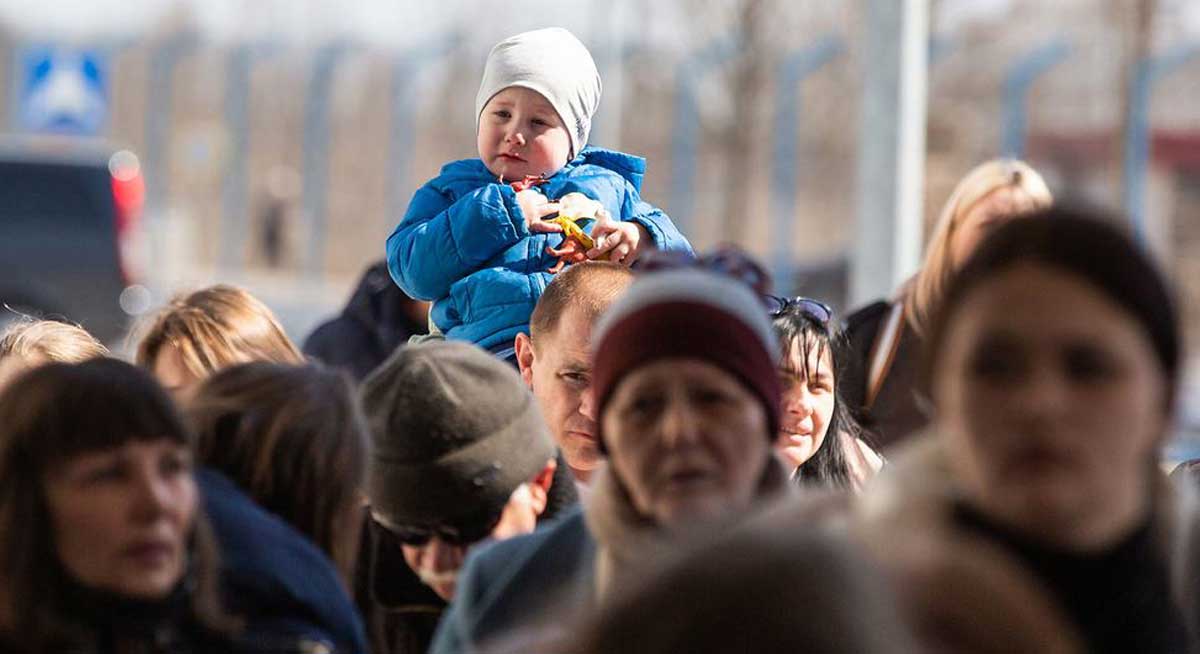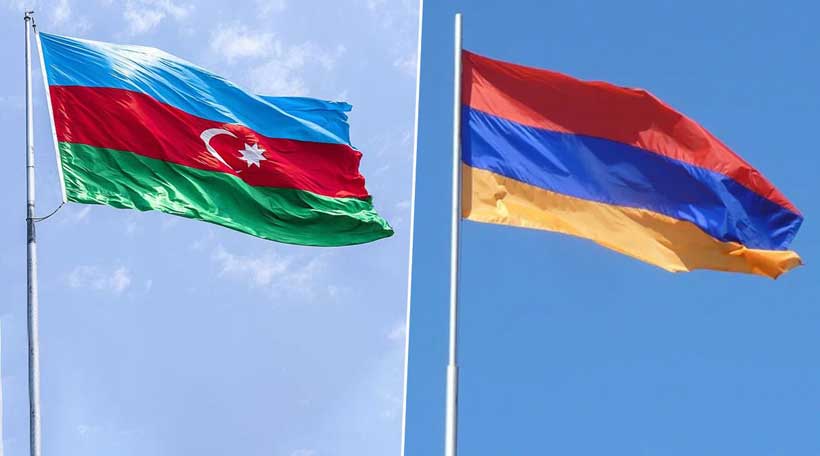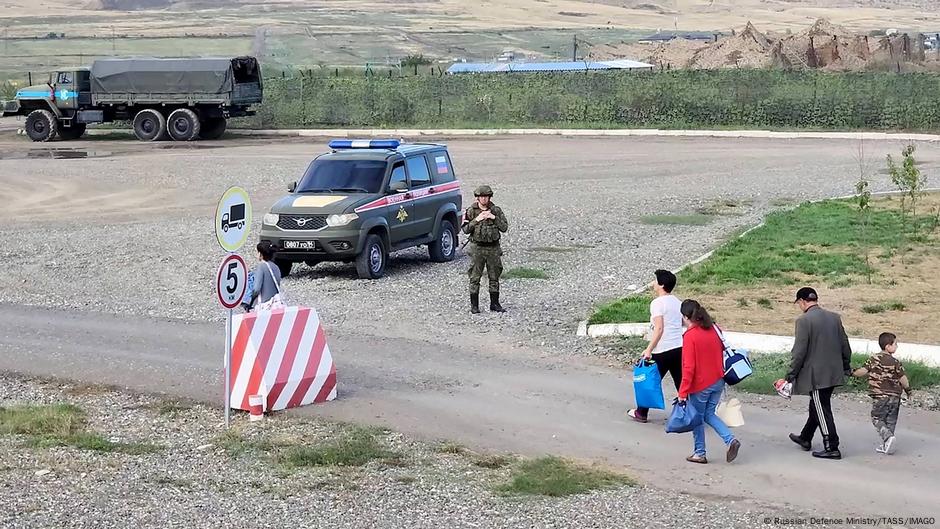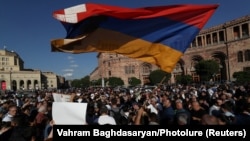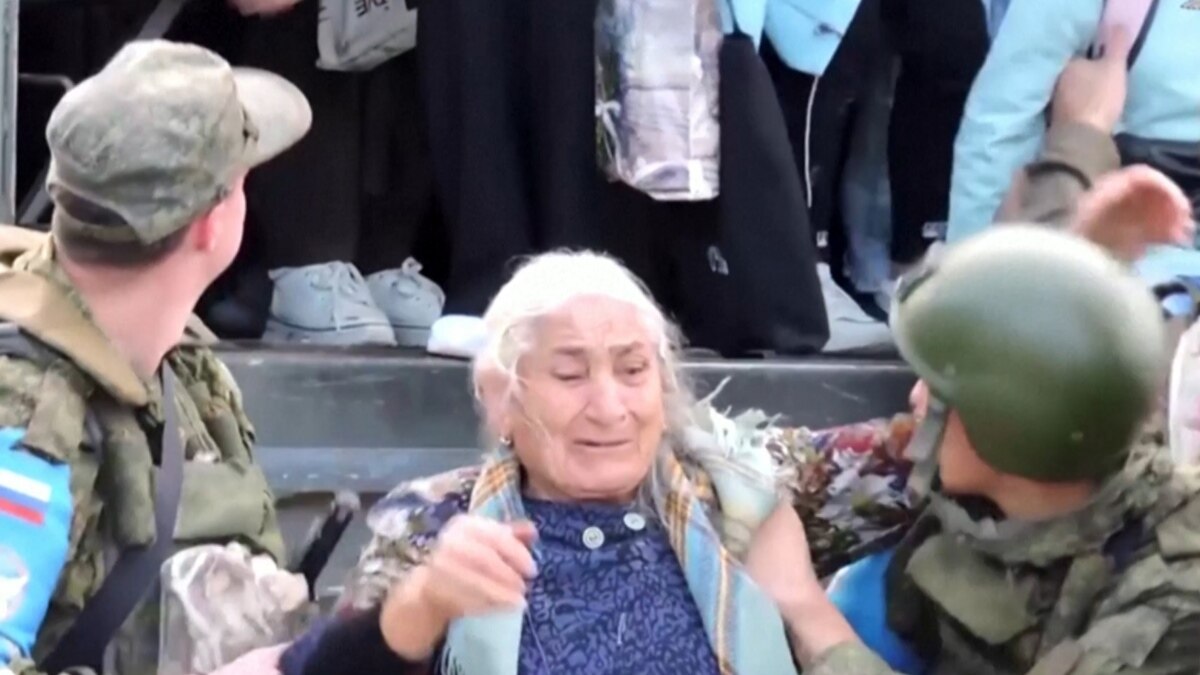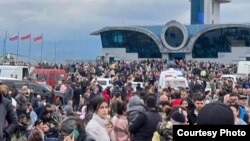Thousands of panicked ethnic Armenians converged on the airport in Nagorno-Karabakh where Russian peacekeeping forces are based after de facto leaders of the breakaway region agreed to lay down their arms and accept talks to “reintegrate” the territory into bitter rival Azerbaijan.
Amid the chaos on September 20, the Russian Defense Ministry reported that an unknown number of the country’s peacekeepers were killed when their vehicle was fired upon while returning from an observation post in the region.
Details remained scarce in the incident, and information could not immediately be verified. Russia authorities said peacekeeping teams were continuing to work with both sides, adding that 3,154 people, including 1,428 children, had been evacuated to safe areas.
Earlier, Azerbaijani leaders on September 20 vowed to allow “safe passage” to Armenia for the separatist forces of the region as part of the agreement to end fighting, seemingly putting an end to a decades-long struggle for ethnic Armenians seeking independence or attachment to Armenia for the territory.
“Safe passage to appropriate assembly points will also be provided by the Azerbaijani side,” presidential adviser Hikmet Hajiyev told reporters. “All the actions on the ground are coordinated with Russian peacekeepers.”
The president of the European Council, Charles Michel, urged Azerbaijani President Ilham Aliyev in a phone call to protect the rights of ethnic Armenians in the region and “to ensure full cease-fire and safe, dignified treatment by Azerbaijan of Karabakh Armenians.”
“Their human rights and security need to be ensured. Access needed for immediate humanitarian assistance,” Michel wrote on social media.
Aliyev, in a national address, said Azerbaijan had “restored sovereignty” after the latest developments in Karabakh. He claimed Baku had “nothing against” the people of the region, only its “criminal leadership.”
Aliyev declared his country’s military operation over and said separatist forces had begun withdrawing from Nagorno-Karabakh.
Separatist leaders said at least 200 people had been killed and 400 wounded in Baku’s latest military drive.
Photo Gallery:
Flights between Iran and Azerbaijan and Armenia resumed on September 20 following the cease-fire, the semiofficial ISNA news agency reported. Iran had earlier canceled all flights to Azerbaijan and Armenia until further notice for security reasons.
Earlier in the day, the Azerbaijani and ethnic Armenian sides agreed to an immediate cease-fire on the second day of a major flare-up in fighting over the territory of Nagorno-Karabakh.
The de facto leadership of the mostly ethnic Armenian enclave accepted a proposal by the Russian peacekeeping mission there and agreed to talks on the territory’s “reintegration” into Azerbaijan.
The expected halt in intense fighting in the decades-old Caucasus hot spot came as international concerns mounted of a widening conflict and as the death toll mounted in the deadliest military escalation there in nearly three years.
The apparent concession came hours after Baku had signaled its intention to continue its military operations in the absence of a surrender by ethnic Armenian forces despite appeals from the United Nations, Western powers, and Russia for a halt to the hostilities that have killed dozens in the past 24 hours.
Local officials reported that fighting had mostly ceased by the agreed time of 1 p.m. local time. The Russian Defense Ministry later said that “no cases of cease-fire violations have been recorded.”
The ethnic Armenian leadership of the territory they call Artsakh, which is recognized as part of Azerbaijan but for decades until late 2020 was controlled by Armenians, reported accepting the Russian proposal about an hour earlier.
It also accepted a proposal from Baku on talks to integrate the region into Azerbaijan, a potentially bitter pill to swallow for the government and public in neighboring Armenia, which has made control of Nagorno-Karabakh a nationalist keystone since the breakup of the Soviet Union and where anti-government protests greeted news of the latest Azerbaijani offensive.
Both sides agreed to talks on September 21 in the Azerbaijani city of Yevlax, about 265 kilometers west of Baku. The Kremlin said Russian peacekeepers would mediate the talks.
Nagorno-Karabakh’s de facto leadership in Stepanakert said that “issues raised by the Azerbaijani side on reintegration, ensuring the rights and security of the Armenians of Nagorno-Karabakh…will be discussed at a meeting between representatives of the local Armenian population and the central authorities of the Republic of Azerbaijan.”
The Azerbaijani Presidency and Defense Ministry confirmed agreeing to the cease-fire.
Aliyev’s office issued a similarly worded statement announcing a meeting that “representatives of the Armenian residents of Karabakh to discuss reintegration issues based on the constitution and laws of the Republic of Azerbaijan” at the Yevlax meeting.
In addition to a suspension of fighting and some sort of integration effort, the cease-fire proposal reportedly includes a commitment for a pullout of any “remaining units of the armed forces of Armenia,” the withdrawal and destruction of any heavy military equipment from the territory, and the disbandment of the so-called Artsakh Defense Army established by ethnic Armenians in the early 1990s at an early phase of the conflict.
It was a dramatic turn in a fast-moving crisis that sent shock waves through the region and beyond.
Armenia’s embattled prime minister, Nikol Pashinian, who was blamed by nationalists and other critics for losses in the 2020 fighting, noted the cease-fire but immediately distanced his government from its terms.
“Armenia did not participate in drafting the text of the cease-fire declaration in Nagorno-Karabakh under the mediation of Russian peacekeepers,” Pashinian told the nation in a televised appearance, according to AFP.
He added in a shot at Baku’s justification for its offensive that Yerevan “has not had an army” in Nagorno-Karabakh since August 2021.
In the capital, Yerevan, thousands of people gathered to demand the government do more to help the ethnic Armenians of Nagorno-Karabakh, with some calling for Pashinian’s resignation.
Pashinian said the “latest information from Nagorno-Karabakh is that the intensity of fighting has greatly decreased.”
He also expressed hope that there would be no new military escalation.
“Now the most important issue is that the right of Nagorno-Karabakh Armenians to live in their homes is fully ensured by the Russian Federation,” he said, according to RFE/RL’s Armenian Service.
A deputy foreign minister in Armenia had been quoted by Reuters as saying a further accumulation of Azerbaijani forces appeared to be readying a “second stage” of the operation.
WATCH: Protests broke out in the Armenian capital, Yerevan, after Azerbaijan launched a military assault on ethnic-Armenian inhabited areas of Nagorno-Karabakh on September 19. Angry crowds gathered outside government buildings, calling for Prime Minister Nikol Pashinian to resign, and clashed with police.
The Armenian government said Pashinian discussed the situation with Russian President Vladimir Putin, who many Armenians have accused of not living up to promises of Russian protection in Nagorno-Karabakh.
The European Union’s diplomatic service said that it took note of the cease-fire and is “following the development of the situation.” It added a warning to Baku against “using the military operations as an excuse for the forced displacement of the Armenians of Nagorno-Karabakh.”
Hours earlier, Azerbaijan’s Defense Ministry said that what it has described as an “anti-terrorist operation” targeting saboteurs was continuing “successfully.” It eventually described capturing 90 Armenian positions in a day of fighting.
Aliyev had also issued a statement saying he had told U.S. Secretary of State Antony Blinken in a phone call “that anti-terrorist measures will be stopped if [forces in Karabakh] lay down their arms.”
The UN Security Council, meanwhile, scheduled an emergency meeting for September 21 as the international community sought ways to avoid an intensification of a long-running conflict that has already sparked two intense wars between the post-Soviet Caucasus neighbors, most recently just three years ago.
The de facto human rights ombudsman in the ethnic Armenian-controlled Azerbaijani region said early on September 20 that 32 people had been killed, including seven civilians, two of them children, and more than 200 wounded as a result of shelling, although some death estimates put the death toll considerably higher.
“The secretary-general calls in the strongest terms for an immediate end to the fighting, de-escalation, and stricter observance of the 2020 cease-fire and principles of international humanitarian law,” UN Secretary-General Antonio Guterres’s spokesman, Stephane Dujarric said.
WATCH: Azerbaijan on September 19 said it had launched an “anti-terrorist operation” in Nagorno-Karabakh following recent bloody clashes and a monthslong blockade of the breakaway territory. The de facto human rights ombudsman in the ethnic Armenian-controlled Azerbaijani region said that two civilians had been killed and 23 wounded — including at least eight children — in the attacks.
Blinken spoke by telephone with the leaders of both countries late on September 19.
The U.S. State Department said he urged Aliyev to stop military operations in Nagorno-Karabakh, which is internationally recognized as Azerbaijani territory, immediately and return to dialogue.
Blinken “noted President Aliyev’s expressed readiness to halt military actions and for representatives of Azerbaijan and the population of Nagorno-Karabakh to meet, and he underscored the need for immediate implementation,” according to the State Department.
Blinken reportedly told Pashinian that the United States “fully supports Armenia’s sovereignty, independence, and territorial integrity.”
A U.S. military spokesperson said the outbreak of fighting did not affect the ongoing 10-day joint military exercises with Armenian troops in Armenia, dubbed Eagle Partner 2023, which were scheduled to conclude on September 20.
In an increasingly rare show of agreement with the West, Moscow called on both sides to stop the violence.
Russian state television on September 20 showed Russian President Vladimir Putin alongside visiting Chinese Foreign Minister Wang Yi saying Moscow was “in close contact with all sides to the conflict” and expressing hope to reach “de-escalation and transfer a solution to this problem to a peaceful course.” It was unclear whether he was speaking before or after word of the cease-fire deal.
It added that Russian peacekeepers were assisting the civilian population in Nagorno-Karabakh, made up mostly of around 120,000 ethnic Armenians, and providing medical and evacuation assistance.
TASS quoted the Russian Defense Ministry as saying on September 20 that its peacekeepers had evacuated more than 2,000 civilians from Nagorno-Karabakh.
After weeks of bloody skirmishes and one day after an aid shipment was finally allowed into the area, Azerbaijan launched the major escalation on September 19 with the breakaway region already teetering on the brink of a humanitarian crisis after being essentially blockaded for more than eight months despite international calls for Baku to allow food and other shipments.
The shelling started shortly after Azerbaijan blamed what it called “Armenian sabotage groups” for two separate explosions that killed at least four military personnel and two civilians in areas of Nagorno-Karabakh that are under the control of Russian peacekeepers.
Those peacekeepers are in place since a cease-fire that ended six weeks of fighting in 2020 in which Azerbaijan recaptured much of the territory and seven surrounding districts controlled since the 1990s by ethnic Armenians with Yerevan’s support.
With reporting by AFP, AP, and Reuters
